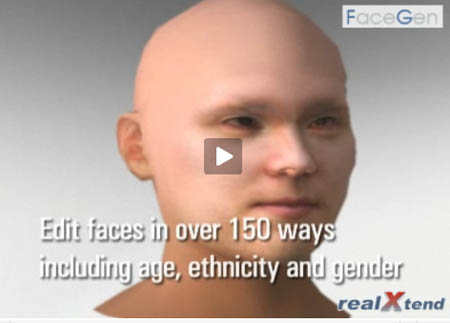It is jaw dropping the number of new features that realXtend has brought to the Second Life â„¢ (A registered Trademark of Linden Lab) open source client and OpenSim server tech in only a few short months. Last week the Rex team posted a video showing inverse kinematics, character morph controls, and clothing physics- see here. And, this week they have revealed their latest feature – the integration of Facegen (see the video here or click on the screenshot above).
I attended realXtend’s recent open meeting in Second Life. The Rex team answered questions to an eager crowd that included, the Second Life avatar, G2 Proto, of Kyle “G” the lead developer from G2 (see here for more on their hardware and networking division). Kyle “G” is currently involved in a collaborative effort with Microsoft to explore the abilities of the C#/.NET based OpenSim software. He is spearheading efforts with the Second Life Microsoft .Net User Group to create the Microsoft’s new developer community OpenSim grid – Project Manhattan. Kyle seemed very interested in the work of realXtend! I have an in depth interview with Kyle from G2 and Zain from Microsoft that details their vision for Virtual World Developer and Platform Evangelism on Open Sim. I am transcribing this and will post soon!
Interview with Jani Pirkola
Jani Pirkola, Rex’s Project Manager, kindly took some time to answer a few questions in the middle of this very busy and exciting time for Rex. The new Rex video showing the Facegen integration has just been posted on the Rex media page. Jani said:
It is almost scary as it is so real! I really start to see that we are approaching something so real as in Snowcrash or Otherland series of books. You can also make yourself look younger or older, different gender or race.
Tish: Wow!! Congratulations to the realXtend team you really have shown the world what can be done with the open source Second Life client and achieved what many considered impossible at this stage! These two new avatar tech videos are awesome!
Jani: Well, the main focus of our work at the moment is on Avatar. We have integrated Facegen so that you can use photos from your own face to create your own avatar.
We are just about to release new versions of viewer and server, and we start to host public avatar storage and authentication services to promote the future internet and avatar portability.
Now we have a lot of work to do on planning. But we are going to focus on three tracks:
1) a base track to fix stability issues.
2) a user experience track to make it look extremely good.
3) a collaboration track to do all the document sharing stuff.
In the new software release we have some cool new features. For example, you can have friends list working no matter where you and your friends are, so it works across realXtend grids and worlds. The same is true for your personal inventory, you can have that too with you when you teleport to different worlds.
Tish: One of the great things Rex has done is to offer so many new and great features so fast that you have for the first time created a situation where content developers have a significant new incentive to start working in an OpenSim grid. Are you beginning to see interest from content developers?
Jani: Yes, I have received many contacts for example from architects, they see the value of using real 3D models in virtual worlds. Professor François Garnier of Ecole Nationale Supérieur des Arts Décoratifs de Paris is one of the early adopters of realXtend platform in their art productions.
Tish: Obviously SL has a huge lead on content production and will probably offer licensing to open grids that want to share content at some point? But, what new models for content production do you see emerging in the Open Metaverse?
Jani: From Second Life users we have heard some complaining about the IP rights issue. They would die to have that feature on realXtend. But we have a plan for this; We could make an object rights server, that keeps SHA1 hash values of all the assets and licenses how to use that asset plus information about which users are allowed to use that asset.
Then it is possible to build a feature to the viewer that users can check if someone is using stolen or bought jacket. That creates a social pressure instead of trying to technically prevent copying. Technical prevention is always going to fail in the end, so we need to use social pressure instead. For example, If everyone could check whether an asset is owned or stolen, someone who is representing a company would not want to use anything stolen on them.
Ben Goertzel, Novamente, said that if someone steals his AI pet dog, it is a dead dog without the AI that runs on his server. Philip Rosedale was in agreement on this point also. Philip said much the same thing when he attended our Open Source Virtual Worlds panel at VW 2008.
If you really want to protect some content, you need to have server side functionality attached to it. This combined with our idea of using asset hash on a server, we think would boost the content creation.
realXtend offers possibility to use OGRE meshes and world is full of ready made 3D models that you can convert to that format. So that solves at least part of the initial egg-chicken content problem for realXtend.
Tish: Some people are proclaiming the notion of a virtual economy is dead, others say that virtual economies still have legs. What is your view on this?
Jani: First of all, I am an engineer, so economics is not my cup of tea. Still it seems that virtual money is successful in many games and virtual worlds. If it can be tied to RL money, that can be a source of many problems, like money laundering. I am not ready to say it is dead, but we might have to wait to see what future brings in this area.
Tish: There is a lot of work on interoperability going on right now. I even heard that Qwaq is considering working on interoperability with OpenSim! And I heard Rex is in talks with Solipsis. What are Rex’s goals for interoperability? I know in order to develop some of the super cool features of Rex you are not currently integrated with the OS trunk. But Adam Frisby mentioned to me a way you could remain integrated with OpenSim but still have the freedom to be the trail blazers of the future. Could you tell me more about your plans for compatibility with OpenSim in the future?
Jani: Yes, right now we are in warm talks with Solipsis to figure out how to co-operate the best possible way. Lets see what comes out from that. Their technological ideology is the best I can think of, combination of both client-server and peer-to-peer to get best of both of the worlds.
The focus in realXtend is to lead the development. There is a secondary goal to be interoperable whenever it makes sense. I just heard from Adam that the latest OpenSim is rock solid, so that is a big incentive for us to continue our efforts to modify realXtend code to be compatible with them. The goal here is to make realXtend as modules for OpenSim for easy integration.
Tish: Rex has blazed the trail with facilitating the import/export of meshes! But large meshes from programs like 3D max, while they create totally new opportunities for applications and content development, can be time consuming to work in and often require a lot of time on the import /export work, and they can be difficult to fine tune in world. One of the dreams for the future might be prim meshes that would bring the best of both worlds together (prim and mesh) do you see this as a possibility? I have heard many obstacles from bandwidth to graphic card inadequacies. But as Rex now has a reputation for doing the impossible I am asking your view on whether prim meshes are on the horizon? If not what are you doing to make meshes more flexible and easy to work with in world?
Jani: That is an interesting idea, and we have toyed ourselves with it already. It is definitely not impossible, though we have not made any decisions whether we will implement it or not.
We are going to do a lot of improvements to world building tools and add new possibilities like projectors, and things that are familiar from game level editing tools. Mesh selection is going to be fixed, for example. So you can expect much more in the area of world building. We are doing a lot of world building ourselves and have found it too cumbersome at the moment.
Tish: OpenSim is definitely the fastest forward moving kid on the metaverse block. I know that the Rex avatar server is out and the Rex grid open. But, as I have a Mac I have no first hand experience, so I am interested to know how well things are progressing re stability, concurrency and ability to scale?
Jani: Those are currently the weak points we have, but we are going to attack also these in the near future. The stability is number one, it is a must for every application out there.
Tish: OpenSim is beginning to get a lot of interest from major corporate players. IBM, Microsoft, Intel, are three of the big ones. How do you think this will effect Rex and the developing ecosystem of OpenSim?
Jani: I think you could compare OpenSim and realXtend to operating system and a windowing system. realXtend is built on OpenSim, so every big company who starts to use OpenSim, will consider using realXtend as well. By using realXtend, you actually use OpenSim server plus some modifications we have done to enable all the new features.
I am sure that OpenSim and realXtend benefit each other as the whole ecosystem looks richer that way.
Tish: Recently I talked to several key metaverse developers in Japan and the integration of 3D immersive and mobile tech is very much part of their vision. But Japanese cell phone habits make the possibilities for interesting integration very rich. In Europe and the US what interesting directions do you think this integration with 3D immersive and mobile could take?
Jani: That is something we have given a lot of thought to, but we haven’t found a clear answer yet. One idea is that there could be communication application that you can use to have presence in the virtual world even when you are on the move.



0 Comments For This Post
4 Trackbacks For This Post
May 25th, 2008 at 11:44 am
[...] admit, not yet very impressive as far as body language and facial expression is concerned. The blog UgoTrade however is on top of the new developments in Avatar Technology, for instance informing us about the [...]
June 6th, 2008 at 2:02 pm
[...] code is proprietary or open source. However, it does seem a big shame when realXtend talk about a base track to fix stability issues that none of this basic infrastructure work, at the very least, is finding it’s way back into [...]
July 8th, 2008 at 11:09 pm
[...] Tribal Net and realXtend have led the way re innovation with OpenSim technology (see my posts here, here, here for realXtend and here for Tribal Net). And, both are now in early discussions with OSGrid re [...]
July 23rd, 2008 at 2:35 pm
[...] the diverse projects OpenSim has spawned including the highly innovative realXtend (see here, here, here and here -my most recent post on reX) and Tribal Net (see here). But Adam includes an excellent [...]